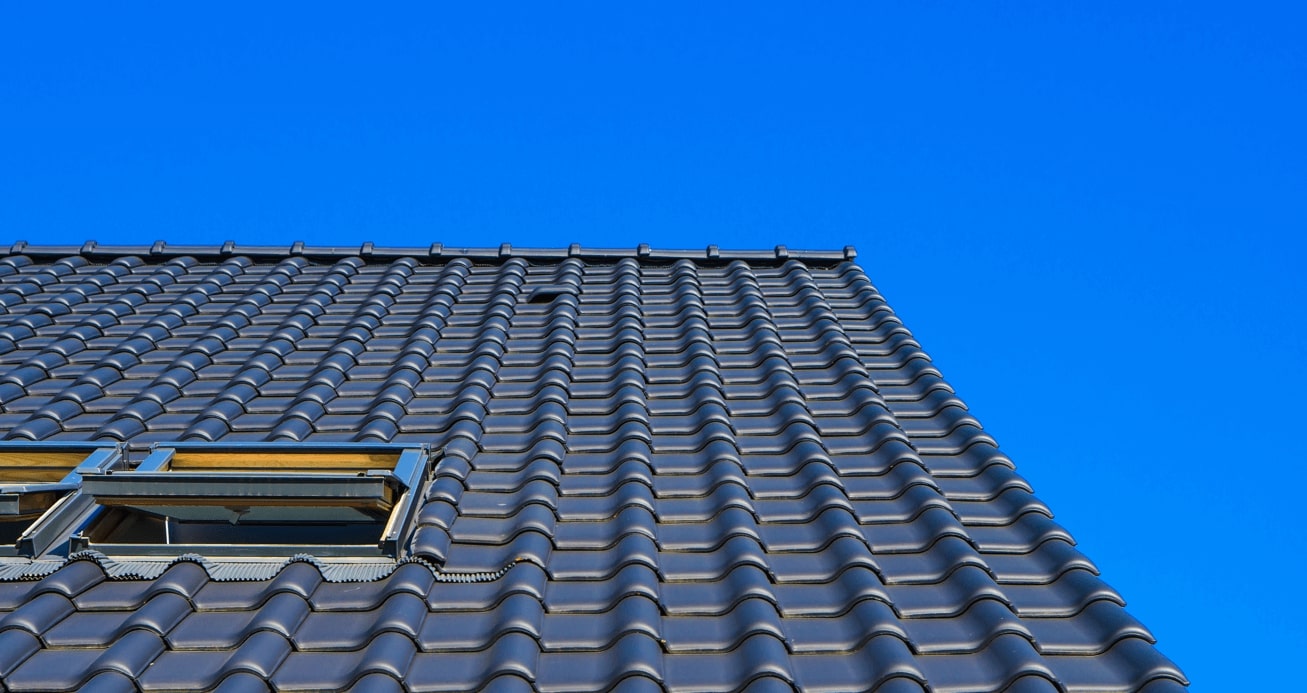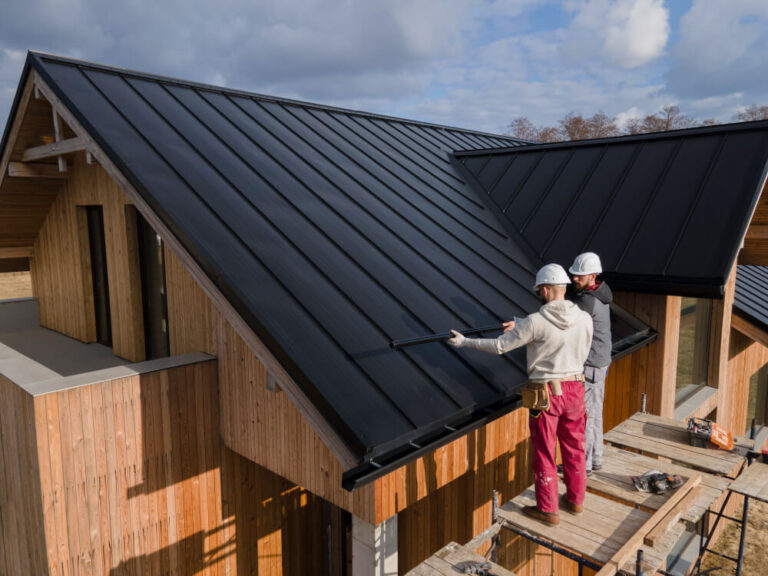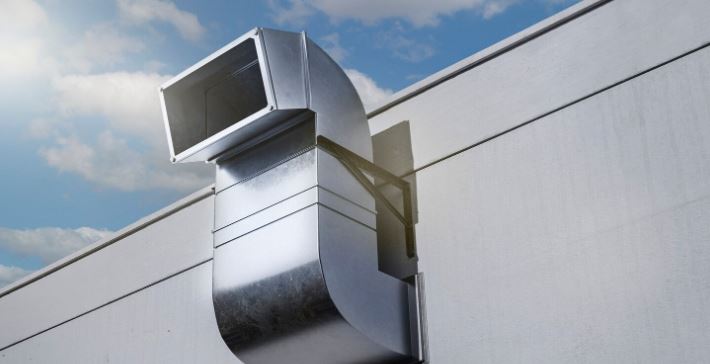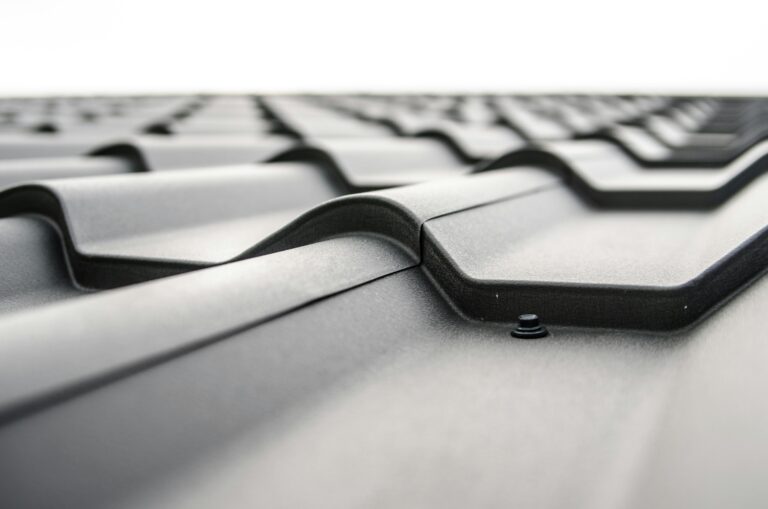Whether you’re building a new home, replacing an old roof, or simply exploring your options, understanding the different types of roofs used across the country can help you make the best decision for your property and budget.
Below, we break down every major roof type found in the US, including detailed descriptions, average costs, pros, cons, and ideal applications.
1. Gable Roof
The gable roof is the most common and recognizable roof style in the United States. It consists of two sloping sides that meet at a central ridge, forming a triangular shape at each end of the house. This design is simple, effective at shedding water and snow, and provides ample attic space for storage or ventilation. Gable roofs are highly versatile and can be constructed with a variety of pitches, from steep to shallow, making them suitable for many architectural styles, including Colonial, Cape Cod, and Ranch homes. The straightforward design also makes gable roofs easier and less expensive to build and repair compared to more complex roof types.
Average Cost:
$8,000–$16,000 for a 2,000 sq. ft. home (asphalt shingles). Costs can increase with steeper pitches, premium materials, or additional features like dormers.
Pros:
- Simple design, easy and cost-effective to build and repair
- Excellent for ventilation and attic space, allowing for better airflow and insulation
- Sheds water and snow efficiently, reducing the risk of leaks and ice dams
- Works well with most home designs and is compatible with a wide range of roofing materials
Cons:
- Can be vulnerable to wind damage if not properly braced, as strong winds can create uplift under the eaves
- May require additional support or hurricane straps in areas prone to severe storms
- Open gable ends can be susceptible to water intrusion if not properly flashed and sealed
Best For:
Most residential homes, especially in areas with moderate climates. Gable roofs are ideal for homeowners seeking a classic look, efficient water drainage, and a cost-effective roofing solution.
2. Hip Roof
A hip roof features four sloping sides of equal length that meet at the top to form a ridge or a point. Unlike gable roofs, hip roofs have no vertical ends, which makes them more stable and resistant to wind. The inward slope on all four sides provides extra strength and durability, making hip roofs a popular choice in regions prone to hurricanes and high winds. Hip roofs can be designed with a gentle or steep pitch and are often seen on bungalows, cottages, and modern homes. The design also allows for wraparound eaves, which can provide additional shade and protection for the exterior walls.
Average Cost:
$12,000–$24,000 for a 2,000 sq. ft. home (asphalt shingles). The complexity of the design and the need for more materials and labor can increase costs, especially with premium materials.
Pros:
- Very stable and durable, especially in high-wind and hurricane-prone areas
- Eaves on all sides offer better shade and protection from the elements
- Attractive, symmetrical appearance that suits many architectural styles
- Can accommodate features like dormers and crow’s nests for added space and light
Cons:
- More complex and expensive to build due to the additional rafters and trusses required
- Less attic space compared to gable roofs, which can limit storage or ventilation options
- More valleys and seams can increase the risk of leaks if not properly installed
Best For:
Homes in hurricane or high-wind zones, as well as those seeking a balanced, elegant look. Hip roofs are also a good choice for homes with wraparound porches or those needing extra shade.
3. Flat Roof
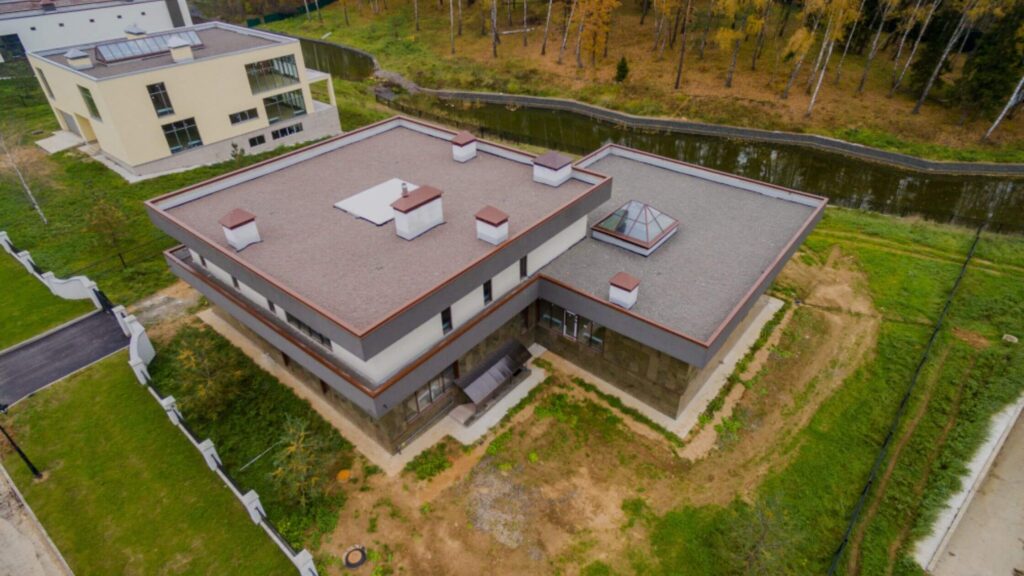
Flat roofs have a very low pitch, typically less than 10 degrees, and appear almost level to the naked eye. While most commonly used on commercial buildings, flat roofs are also popular in modern and mid-century residential architecture. Flat roofs require special materials, such as modified bitumen, TPO, or EPDM rubber, to create a waterproof barrier. They are ideal for maximizing usable space, as they can support rooftop gardens, patios, or HVAC equipment. However, flat roofs require careful design and installation to ensure proper drainage, as standing water can lead to leaks and structural damage.
Average Cost:
$7,000–$15,000 for a 2,000 sq. ft. home (using modified bitumen or TPO). Costs can vary based on the type of membrane, insulation, and any additional features like rooftop decks.
Pros:
- Easy to build, access, and maintain, making repairs and inspections straightforward
- Can be used for rooftop gardens, patios, solar panels, or HVAC units, maximizing usable space
- Modern, minimalist aesthetic that complements contemporary home designs
- Lower initial construction cost compared to complex pitched roofs
Cons:
- Prone to drainage issues and leaks if not properly sloped and maintained
- Shorter lifespan than pitched roofs, especially in areas with heavy rainfall or snow
- Requires regular inspections and maintenance to prevent water pooling and membrane damage
Best For:
Commercial buildings, modern homes, and urban areas where space is at a premium. Flat roofs are also ideal for homeowners interested in green roofs or rooftop living spaces.
Also Check: How long does a roof last – Detailed analysis
4. Mansard Roof
A mansard roof, also known as a French roof, is a four-sided roof with two slopes on each side. The lower slope is much steeper than the upper, often almost vertical, while the upper slope is relatively flat. This design maximizes the amount of usable space in the attic, allowing for additional living quarters, storage, or even a full extra floor. Mansard roofs are a hallmark of French and Second Empire architecture, giving homes an elegant, classic appearance. The design can be customized with dormer windows, decorative trim, and other architectural details.
Average Cost:
$18,000–$40,000 for a 2,000 sq. ft. home (asphalt shingles). The complexity of the design, the need for custom framing, and the addition of dormers or decorative elements can significantly increase costs.
Pros:
- Adds extra living or storage space, making it ideal for homes needing more square footage
- Elegant, classic appearance that enhances curb appeal and property value
- Flexible design allows for customization with windows, balconies, and decorative features
- Can improve natural light and ventilation in upper floors
Cons:
- Expensive and complex to build, requiring skilled labor and custom materials
- May require more maintenance due to the multiple slopes and potential for water pooling on the upper slope
- Not ideal for areas with heavy snowfall, as the flat upper slope can accumulate snow and ice
Best For:
Historic homes, urban infill projects, and properties where maximizing interior space is a priority. Mansard roofs are also popular for luxury homes and buildings seeking a distinctive architectural style.
5. Gambrel Roof
The gambrel roof is similar to a mansard roof but has only two sides, each with two slopes. The lower slope is steeper than the upper, creating a barn-like appearance. This design is often seen on barns, farmhouses, and Dutch colonial homes. The double slope on each side creates more headroom and usable space in the upper levels, making it ideal for attics, lofts, or storage. Gambrel roofs are relatively easy to frame and can be constructed with a variety of materials.
Average Cost:
$13,000–$25,000 for a 2,000 sq. ft. home (asphalt shingles). Costs can increase with the addition of dormers, windows, or premium materials.
Pros:
- Maximizes upper-level space, making it ideal for homes needing large attics or lofts
- Classic, rustic look that suits traditional and rural architecture
- Simple framing compared to more complex roof types
- Good for adding windows or dormers for natural light
Cons:
- Not ideal for high-wind or heavy snow areas, as the design can be vulnerable to uplift and snow accumulation
- May require additional bracing or reinforcement in severe weather regions
- The steep lower slope can make maintenance and repairs more challenging
Best For:
Barns, farmhouses, Dutch colonial homes, and properties seeking a traditional, spacious design. Gambrel roofs are also popular for sheds and outbuildings.
Also Check: How Much Does It Cost to Replace a Roof on a 2,200 Square Foot House?
6. Shed Roof
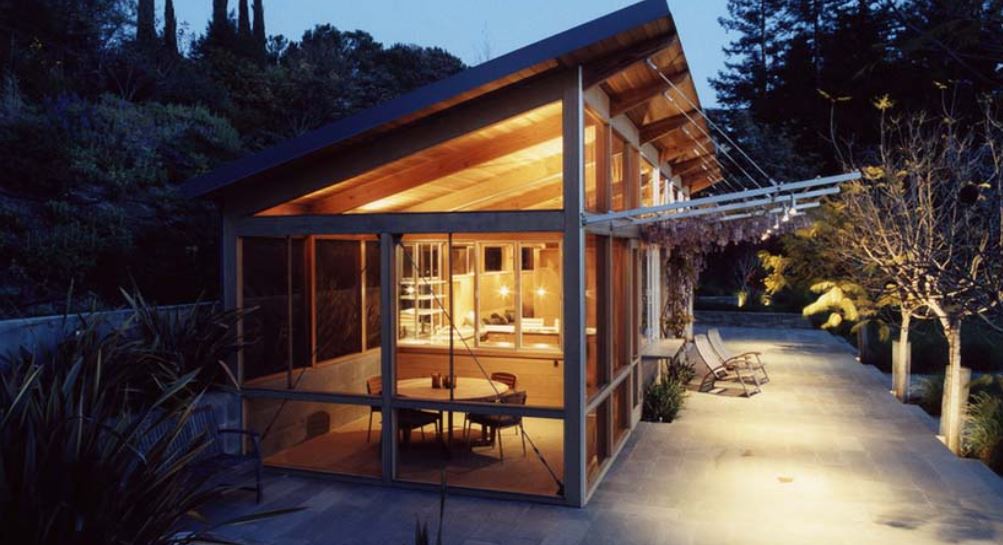
A shed roof, also known as a skillion or lean-to roof, consists of a single sloping plane. It is one of the simplest roof designs and is often used for home additions, porches, sheds, and modern homes. Shed roofs are easy to construct and require fewer materials than more complex designs. The single slope allows for efficient water drainage and is ideal for installing solar panels. Shed roofs can be built with a steep or shallow pitch, depending on the desired look and function.
Average Cost:
$8,000–$16,000 for a 2,000 sq. ft. home (asphalt shingles). Costs can vary based on pitch, materials, and integration with existing structures.
Pros:
- Simple and affordable to build, making it a cost-effective option for additions and small homes
- Good for solar panel installation due to the large, unobstructed surface
- Modern, minimalist appearance that suits contemporary architecture
- Efficient water drainage, reducing the risk of leaks
Cons:
- Limited attic space, which can restrict storage or ventilation options
- Not ideal for large homes, as the single slope can create an unbalanced appearance
- May require additional support for heavy snow loads or high winds
Best For:
Modern homes, additions, sheds, porches, and garages. Shed roofs are also a good choice for homeowners seeking a simple, functional, and affordable roofing solution.
7. Butterfly Roof
A butterfly roof features two slopes that angle down toward the center, resembling the wings of a butterfly. This striking, modern design allows for large windows, high ceilings, and efficient rainwater collection. Butterfly roofs are often used in mid-century modern and eco-friendly homes. The central valley can be equipped with a gutter system to collect rainwater for irrigation or other uses. The design also allows for clerestory windows, which bring in natural light and enhance energy efficiency.
Average Cost:
$20,000–$40,000 for a 2,000 sq. ft. home (metal or membrane roofing). The complexity of the design, custom framing, and specialized drainage systems can increase costs.
Pros:
- Unique, modern look that stands out in any neighborhood
- Good for rainwater harvesting and sustainable building practices
- Allows for large windows and high ceilings, enhancing natural light and ventilation
- Can improve energy efficiency with proper orientation and insulation
Cons:
- Complex drainage requirements, as water must be directed away from the central valley to prevent leaks
- Expensive to build and maintain due to custom materials and labor
- May require frequent inspections to ensure proper drainage and prevent water damage
Best For:
Modern, eco-friendly homes, especially in regions with moderate rainfall. Butterfly roofs are ideal for homeowners seeking a distinctive, sustainable design.
8. Dormer Roof
A dormer is not a roof type itself but an addition to a roof, usually gable or hip, that creates extra space and windows in the attic. Dormers project vertically from the main roof, providing headroom, natural light, and ventilation. They come in various styles, including gable, shed, and eyebrow dormers. Dormers can enhance the appearance of a home, add usable space, and increase property value. However, they require careful integration with the main roof to prevent leaks and ensure structural integrity.
Average Cost:
$2,000–$10,000 per dormer (added to main roof cost). The total cost depends on the size, style, and number of dormers, as well as the complexity of the installation. Check our Roofing Cost Calculator for detailed analysis,
Pros:
- Adds natural light and space to upper floors or attics, making them more livable
- Enhances curb appeal and architectural interest
- Can improve ventilation and energy efficiency
- Customizable to match any home style
Cons:
- Adds to overall roof cost, especially with multiple or large dormers
- Can be prone to leaks if not installed properly, due to additional seams and flashing
- May require structural modifications to the existing roof
Best For:
Homes needing more attic space, light, or ventilation. Dormers are also popular for historic renovations and homes seeking a classic, charming appearance.
9. Curved Roof
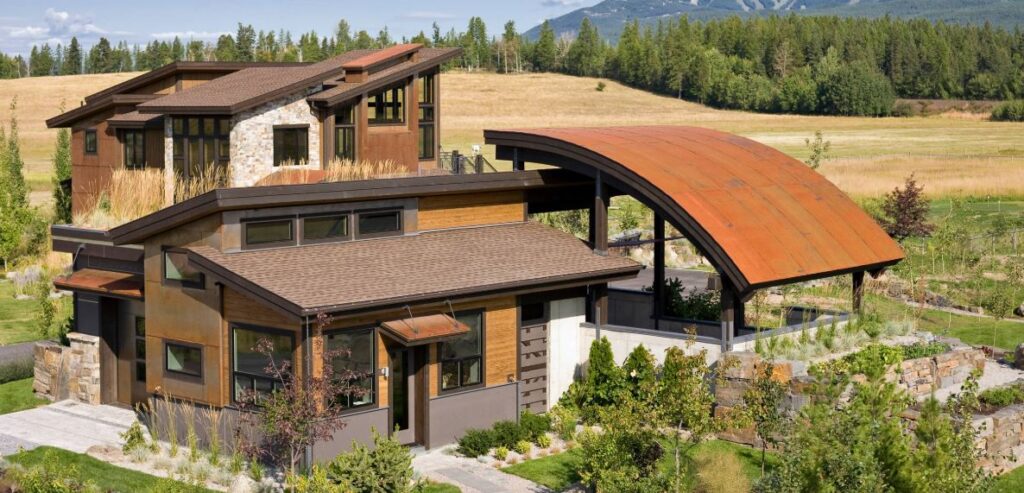
Curved roofs feature a gentle arch or continuous curve, offering a modern and distinctive look. They are often made from metal or special shingles that can bend to the desired shape. Curved roofs can be designed with a low or high arch, depending on the architectural style and functional needs. The smooth, aerodynamic shape provides excellent wind resistance and can create dramatic interior spaces with vaulted ceilings. Curved roofs are often used in custom homes, commercial buildings, and structures seeking a futuristic or organic appearance.
Average Cost:
$25,000–$50,000 for a 2,000 sq. ft. home (metal). Costs can increase with custom framing, premium materials, and complex designs.
Pros:
- Unique, modern appearance that sets a home apart
- Good for wind resistance, as the curved shape deflects strong gusts
- Can create spacious, open interiors with vaulted ceilings
- Suitable for a variety of materials, including metal, shingles, and even green roofing
Cons:
- Expensive and complex to build, requiring skilled labor and custom materials
- Limited contractor experience, which can make finding qualified installers challenging
- May require specialized maintenance and repairs
Best For:
Custom modern homes, commercial buildings, and properties seeking a distinctive, contemporary look. Curved roofs are also popular for eco-friendly designs and structures in windy areas.
10. Pyramid Roof
A pyramid roof is a type of hip roof where all four sides come to a point at the top, forming a pyramid shape. This design is often used on small structures like gazebos, pool houses, and some compact homes. Pyramid roofs are highly stable and wind-resistant due to their symmetrical shape and inward-sloping sides. They can be constructed with a variety of materials and pitches, depending on the desired look and function.
Average Cost:
$10,000–$20,000 for a 2,000 sq. ft. home (asphalt shingles). Costs can vary based on size, materials, and complexity.
Pros:
- Stable and wind-resistant, making them ideal for exposed locations
- Attractive, symmetrical appearance that suits small buildings and outbuildings
- Efficient water runoff from all sides, reducing the risk of leaks
Cons:
- Not practical for large homes, as the design can limit interior space and headroom
- Limited attic or upper-level space compared to other roof types
- May require custom framing and materials for larger structures
Best For:
Gazebos, small homes, outbuildings, and structures needing a stable, weather-resistant roof. Pyramid roofs are also popular for decorative or architectural features.
11. Combination Roof
Combination roofs use two or more roof types on a single building, such as a gable with a hip or a flat section with a shed roof. This approach allows architects and homeowners to customize the appearance and function of a roof to suit specific needs. Combination roofs can solve complex architectural challenges, provide additional space, and enhance curb appeal. However, the increased number of valleys, ridges, and joints can make them more susceptible to leaks and require careful design and installation.
Average Cost:
$15,000–$35,000 for a 2,000 sq. ft. home (varies by materials and complexity). Costs can increase with the number of roof types, custom features, and premium materials.
Pros:
- Customizable for aesthetics and function, allowing for unique and personalized designs
- Can solve complex architectural needs, such as maximizing space or accommodating additions
- Enhances curb appeal and property value with varied rooflines and features
Cons:
- More expensive and complex to build, requiring skilled labor and careful planning
- More potential for leaks at joints, valleys, and intersections
- Maintenance and repairs can be more challenging due to the variety of roof types
Best For:
Custom homes, large or complex buildings, and properties seeking a unique architectural statement. Combination roofs are also ideal for renovations and additions.
12. Saltbox Roof
A saltbox roof has one long, pitched side and one short side, creating an asymmetrical look. This design originated in colonial New England and is known for its ability to shed rain and snow efficiently. The long slope provides extra interior space on one side of the house, while the short slope creates a distinctive profile. Saltbox roofs are often used on historic homes and renovations, but they can also be adapted for modern designs.
Average Cost:
$12,000–$22,000 for a 2,000 sq. ft. home (asphalt shingles). Costs can vary based on pitch, materials, and integration with existing structures.
Pros:
- Good for shedding rain and snow, making it ideal for wet or snowy climates
- Classic, colonial appearance that adds character and charm
- Provides extra interior space on one side of the house
Cons:
- Limited attic space on the short side, which can restrict storage or ventilation
- Asymmetrical design may not suit all architectural styles
- Can be more challenging to frame and build compared to symmetrical roofs
Best For:
Colonial homes, historic renovations, and properties in regions with heavy precipitation. Saltbox roofs are also popular for homeowners seeking a distinctive, traditional look.
13. Bonnet Roof
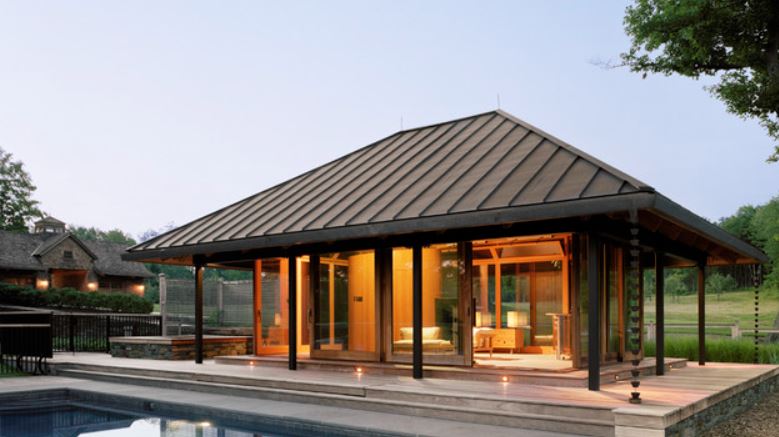
A bonnet roof is similar to a hip roof but with lower slopes that extend beyond the walls, creating a covered porch area. The upper slope is steeper, while the lower slope is more gentle, providing shade and shelter for outdoor spaces. Bonnet roofs are often seen in Southern and coastal homes, where protection from the sun and rain is important. The design can be customized with dormers, decorative trim, and other features.
Average Cost:
$15,000–$30,000 for a 2,000 sq. ft. home (asphalt shingles). Costs can increase with custom features, premium materials, and complex framing.
Pros:
- Provides shade and shelter for porches, patios, and outdoor living areas
- Good water runoff from the extended eaves, reducing the risk of leaks
- Attractive, distinctive appearance that enhances curb appeal
Cons:
- Complex design, higher cost due to additional materials and labor
- May require more maintenance to keep the extended eaves in good condition
- Not ideal for all architectural styles
Best For:
Southern homes, homes with wraparound porches, and properties seeking a blend of indoor and outdoor living. Bonnet roofs are also popular for cottages and vacation homes.
14. Sawtooth Roof
A sawtooth roof features a series of ridges with dual pitches on either side, resembling the teeth of a saw. This design was originally used in industrial buildings to allow for clerestory windows and natural light. Today, sawtooth roofs are also used in modern homes, studios, and commercial spaces. The alternating slopes can be oriented to maximize daylight, reduce energy costs, and create dramatic interior spaces.
Average Cost:
$20,000–$40,000 for a 2,000 sq. ft. home (metal or membrane). Costs can increase with the number of ridges, custom framing, and premium materials.
Pros:
- Allows for clerestory windows and natural light, reducing the need for artificial lighting
- Modern, industrial look that suits contemporary architecture
- Can improve energy efficiency with proper orientation and insulation
Cons:
- Expensive and complex to build, requiring skilled labor and custom materials
- More maintenance required due to the increased number of seams and joints
- May not suit all home styles or neighborhoods
Best For:
Industrial buildings, modern homes, studios, and properties seeking abundant natural light and a unique architectural statement.
15. Green Roof (Living Roof)
A green roof, or living roof, is covered with vegetation and soil, providing insulation and reducing stormwater runoff. Green roofs require a flat or low-slope structure and a waterproof membrane to protect the building. They can be extensive (shallow soil, low-maintenance plants) or intensive (deeper soil, larger plants, and even trees). Green roofs improve air quality, reduce the urban heat island effect, and provide habitat for wildlife. They are increasingly popular in urban areas and eco-friendly buildings.
Average Cost:
$25,000–$50,000 for a 2,000 sq. ft. home. Costs depend on the type of green roof, structural requirements, and plant selection.
Pros:
- Eco-friendly, improves insulation and energy efficiency
- Reduces urban heat island effect and stormwater runoff
- Can provide outdoor living space, gardens, or habitat for wildlife
Cons:
- High initial cost and structural requirements
- Requires ongoing maintenance, including irrigation and plant care
- Not suitable for all climates or building types
Best For:
Urban buildings, eco-friendly homes, commercial properties, and properties seeking to maximize green space and sustainability.
16. Dome Roof

A dome roof is rounded and self-supporting, often used for churches, government buildings, or custom homes. Dome roofs can be constructed from a variety of materials, including metal, concrete, and even glass. The curved shape provides excellent wind resistance and can create dramatic, open interior spaces. Dome roofs are complex to design and build, requiring specialized skills and materials.
Average Cost:
$30,000–$60,000 for a 2,000 sq. ft. home. Costs can increase with custom features, premium materials, and complex engineering.
Pros:
- Unique, dramatic appearance that stands out in any setting
- Excellent wind resistance due to the aerodynamic shape
- Can create spacious, open interiors with vaulted ceilings
Cons:
- Very expensive and complex to build, requiring skilled labor and custom materials
- Limited contractor experience, which can make finding qualified installers challenging
- May require specialized maintenance and repairs
Best For:
Custom homes, religious or public buildings, and properties seeking a distinctive, architectural statement. Dome roofs are also popular for eco-friendly and energy-efficient designs.
Roof Type Comparison Table
| Roof Type | Avg. Cost (2,000 sq. ft.) | Lifespan (years) | Best For | Main Material Options |
|---|---|---|---|---|
| Gable | $8k–$16k | 15–70 | Most homes | Asphalt, metal, tile |
| Hip | $12k–$24k | 20–70 | Wind-prone areas | Asphalt, metal, tile |
| Flat | $7k–$15k | 10–30 | Commercial, modern homes | TPO, EPDM, bitumen |
| Mansard | $18k–$40k | 20–100 | Historic, extra attic space | Asphalt, slate, metal |
| Gambrel | $13k–$25k | 15–40 | Barns, colonial homes | Asphalt, wood, metal |
| Shed | $8k–$16k | 15–70 | Additions, modern homes | Asphalt, metal |
| Butterfly | $20k–$40k | 20–50 | Modern, eco-friendly | Metal, membrane |
| Dormer | $2k–$10k (per dormer) | 15–70 | Attic space, light | Matches main roof |
| Curved | $25k–$50k | 40–70 | Custom, modern | Metal |
| Pyramid | $10k–$20k | 20–70 | Small buildings | Asphalt, metal |
| Combination | $15k–$35k | 15–100 | Custom, complex homes | Varies |
| Saltbox | $12k–$22k | 15–70 | Colonial, historic | Asphalt, wood, metal |
| Bonnet | $15k–$30k | 20–70 | Porches, southern homes | Asphalt, metal |
| Sawtooth | $20k–$40k | 20–50 | Industrial, modern | Metal, membrane |
| Green | $25k–$50k | 20–50 | Urban, eco-friendly | Vegetation, membrane |
| Dome | $30k–$60k | 50–100 | Custom, public buildings | Metal, concrete |
Final Thoughts
Choosing the right roof type is about more than just looks. Consider your climate, budget, home style, and long-term needs. Some roofs are better for snowy regions, while others excel in high winds or hot climates. Always consult with a licensed roofing contractor and use a roofing CRM to track your project, compare options, and store important documents.
If you have questions about which roof type is best for your home, contact a local roofing professional or use our CRM’s project planning tools to get started.
Need help managing your roofing project? Try Roofing Cube CRM for seamless communication, project tracking, and document management—all in one place.
